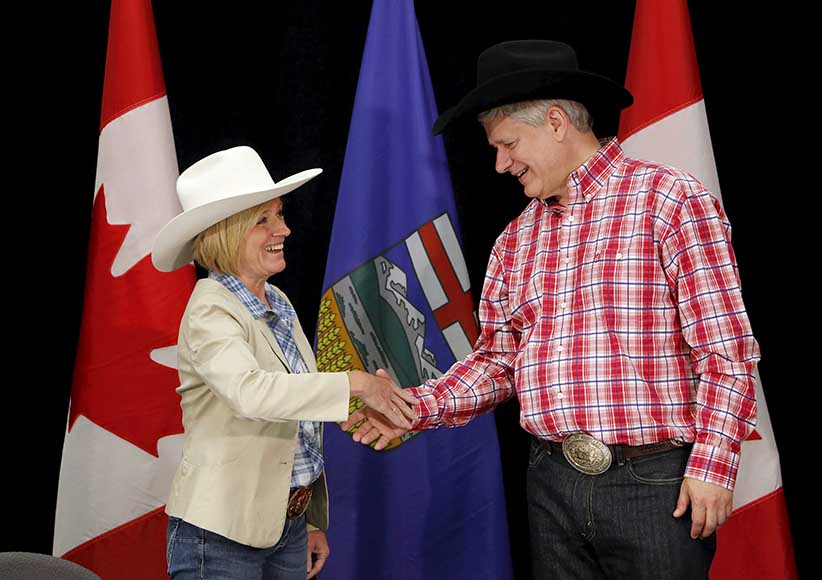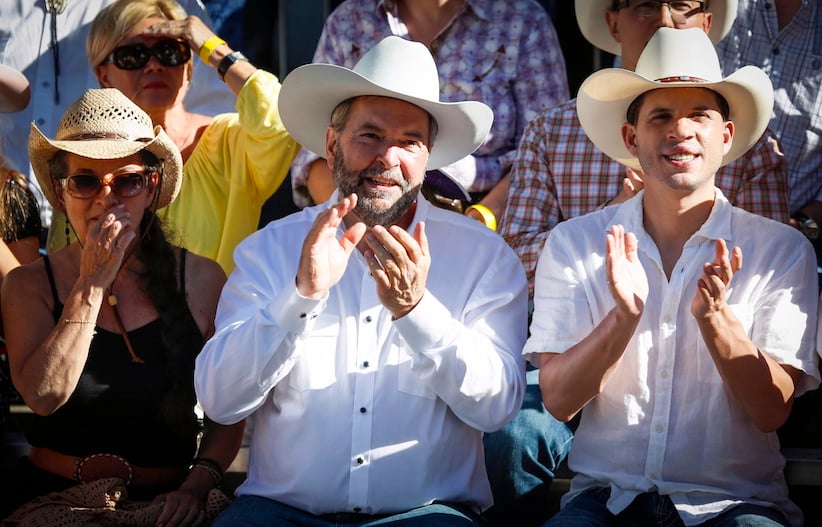Prairie battleground: Who will win the heartland?
The Tory sweeps are over. Alberta and Saskatchewan are suddenly battlegrounds for all three major parties.
The Pengrowth Saddledome stands as one of the icons of the Calgary, Alberta skyline June 25, 2009. Calgary is home to the headquarters of Canada’s oil industry. REUTERS/Todd Korol (CANADA CITYSCAPE SOCIETY TRAVEL)
Share

In American politics, much of the country is divided up in two: battleground states and flyover states. Presidential candidates next year will organize their rallies in places such as Ohio, Florida and Missouri, and will steer clear of regions that are reliably Democratic (Illinois, Michigan) and Republican (the Deep South and the Plains). Residents in the flyover states wonder why the would-be commander-in-chief doesn’t ever shake their hands—to which the answer is: We already know if you’re with us or against us. Sorry, Wyoming, but you’re just too damn predictable.
So it’s been for ages with Canada’s leading flyover province, Alberta. In the last few campaigns, Edmonton couldn’t expect more than a token visit from the main party leaders, while all Calgary would get is an election-day homecoming from a Stephen Harper ready to celebrate with his Conservative brethren and royal-blue balloons at the downtown convention centre.
“We’re focusing our efforts on constituencies we think we can win,” the federal NDP’s Alberta director told the Calgary Herald during the 2011 campaign, when asked if Jack Layton’s plane would touch tarmac in southern Alberta. “In Calgary, it is Conservative country.”
That party organizer, Lou Arab, is married to the new NDP premier. Welcome, Alberta, to the league of politically unpredictable regions.
The Conservatives can no longer count on a sweep, or near-sweep, of the heart of old Reform country. It became clear they’d gotten the picture in late July, when, in separate government announcements, they showered more than $2 billion on Calgary—$1.5 billion toward a light-rail line that cuts through five city ridings, and the rest for a freeway extension within Stephen Harper’s own constituency.
Nobody’s really worried the Prime Minister will pull a Kim Campbell and lose his seat. But some seats in his hometown are up for grabs, after the Liberals have been shut out of Calgary since 1968 and the NDP since . . . forever. Even Alberta party organizers didn’t expect to see Trudeau this early in the campaign, but, on the first full day, a few hundred Liberals showed up at his rally in a Calgary they no longer see as impenetrable Fort Righty. (The Globe and Mail and Google Canada are hosting a debate on Sept. 17 in Calgary, which will draw the leaders and media attention to the city—Stampede redux, in other words.) Edmonton, where the NDP already control one seat, could embrace Rachel Notley’s federal cousins in a big way, or take a new look at Justin Trudeau’s Liberals in a way they never really considered Stéphane Dion or Michael Ignatieff. Even Lethbridge is believed to be in play, or at least New Democrats have it on their radar as never before.
Related: The Calgary Stampede on the stump
Same goes for the flyover-ish province next door, Saskatchewan. In the last two elections, Conservatives secured everything but the Regina seat of Liberal stalwart Ralph Goodale. Progressive parties have renewed hopes in Regina and Saskatoon, thanks to a major redistricting that gave the cities some genuinely urban seats instead of the pizza-pie ridings with carved tips in the city and the full pepperoni pieces in Conservative-friendly rural districts.
This means the major cities in Alberta and Saskatchewan are finally beginning to look politically like cities in the rest of Canada. Leaders will want to visit them, just as they’d hit Vancouver, Ottawa and Halifax. There are locals to flatter and votes to harvest.
The Conservatives are still on track to capture the majority of seats in these provinces, as well as in Manitoba, where the dynamics haven’t shifted as much, but some Winnipeg seats could change hands. Harper’s majority included winning 51 of 56 seats in the Prairie provinces and, while the rural and small-town areas should remain safe, they’ll have to fight to rack up numbers like that again. The Conservative ministers and backbenchers who often help campaigns in other provinces may need to defend their own turfs in 2015.
Harper’s supporters and candidates say the Alberta election was due to anger and fatigue over the four-decade Tory regime, not conservatism in general. Well before the Alberta NDP victory on May 5, other parties sensed opportunity in the petro-province, whose seat total has expanded to 34 from 28. Some trace the progressive trend to Naheed Nenshi’s win as mayor of Calgary in 2010, but, in 2011, the Conservatives enjoyed their best Alberta vote share of the Harper era. The Liberals slumped to third place and single digits in the popular vote, but polls show they began to rebound when Trudeau became leader two years later. He tried early to bury three-decade-old bitter memories of his father’s National Energy Program, pointedly visiting Calgary right after launching his leadership bid, then coming back often. (He introduced the Liberal climate change platform at the Calgary Petroleum Club.) The party attracted Alberta candidates with star power the party hadn’t seen since its governing days: Calgary’s Kent Hehr and Darshan Kang, veteran legislators for the fading Alberta Liberals; and Amarjeet Sohi, a well-liked city councillor for southeast Edmonton.
“We are capable of diversity of thought and electing Liberals in this city, and that is what I thought a year ago,” says Hehr, who’s running against polarizing Conservative MP Joan Crockatt in Calgary Centre. “Since the provincial election, it’s actually broadened that thinking, if anything. We didn’t all of a sudden become a New Democrat province overnight. What we became is a sophisticated electorate.”
Unfortunately for Hehr’s party, the NDP began surging before the provincial election, surpassed the Grits around the time of Notley’s win and haven’t looked back. Regional polls mirror the Canada-wide trend, but it’s sharper in Alberta. The latest Ekos survey has the Liberals down at 16 per cent and the NDP at 32, nipping closer to the Conservatives’ lowered 44. Excitement is highest in Edmonton, where the Notley crew trampled opponents by margins that Ralph Klein once came to presuppose.
Related: The death of the Alberta PC dynasty
Last summer, months before Notley became Alberta NDP leader, Janis Irwin recalls a few hundred people gathering at the federal party’s nomination for Edmonton Griesbach, a newly formed riding that overlaps with three of the provincial seats the NDP held before this year’s takeover. Irwin, an education administrator, won that race, and the NDP is hopeful she can win again against Conservative Kerry Diotte, a former Edmonton councillor and columnist. “We are in really great shape,” says Irwin, a phrase of typically un-NDP confidence in those parts.

The New Democrats are furthest behind in Alberta candidate selection, because their organizers were busy toppling Alberta’s Tory dynasty this spring. (Also, three federal candidates became MLAs.) But holding nominations in August paid off: Many are now hotly contested, and a higher calibre of contenders emerged, including Alberta Federation of Labour president Gil McGowan in Edmonton Centre. That’s the riding former Liberal deputy prime minister Anne McLellan held until her 2006 defeat; it will be a three-way race, with the Liberals fielding a respected entrepreneur and the Conservatives a former Chamber of Commerce president.
The NDP’s growth bodes best in Edmonton and Lethbridge. But while the provincial NDP had the progressive vote to itself, the Trudeau team will be less of a pushover, particularly in Calgary. Stronger Grit candidates there, plus an ascendant NDP, could equal vote splits that protect the Harper Conservatives. That’s how Crockatt won her seat in a 2012 election with 37 per cent of the vote, four points above the Liberal and 11 over the Green candidate. The NDP back then had under four per cent support—small wonder the Liberals’ Hehr is describing the seat as a two-way race.
Conservative candidates will also watch closely to dredge up Western alienation by seizing on any anti-oil-sands or anti-pipeline rhetoric from opposition candidates in the province or outside, and dredge up old leaders’ comments. Low oil prices continue to clobber Alberta’s economy and collective ego, and the Notley government’s triple hit of corporate tax hikes, tougher climate change policy and a review of energy-royalty rates don’t help, either—which Harper has begun to take aim at. The provincial NDP is loath to inflict damage on federal leader Mulcair, and will delay their deficit-mired first budget until after Canada votes. The premier, meanwhile, will keep her respectful distance and doesn’t plan to campaign with the national team. In Calgary, Nenshi had been making noises about vocally pushing an “urban agenda” during the campaign, but a government’s massive transit-funding pledge has a way of mollifying outspoken mayors.
Related: Tories on infrastructure: Buy support now, pay later
In Saskatchewan, where the economy has been less battered, the newly created urban Saskatoon and Regina ridings make it less likely the NDP can again get 32 per cent of the province’s vote and yet win zero seats. After being shut out of Tommy Douglas’s province since 2000, the NDP have their sights on ridings such as Regina-Lewvan and Saskatoon-West, where the local United Way’s longtime CEO is competing.
In Manitoba, where the NDP government is hurting, Trudeau is expected to make serious plays for a couple of Winnipeg seats where Conservatives are retiring, including Heritage Minister Shelly Glover’s in Saint Boniface-Saint Vital. Winnipeg is a city used to hosting repeat party-leader visits during elections. This time, for a change, the Prairies’ other biggest cities will have to ready the red, blue and orange carpets.